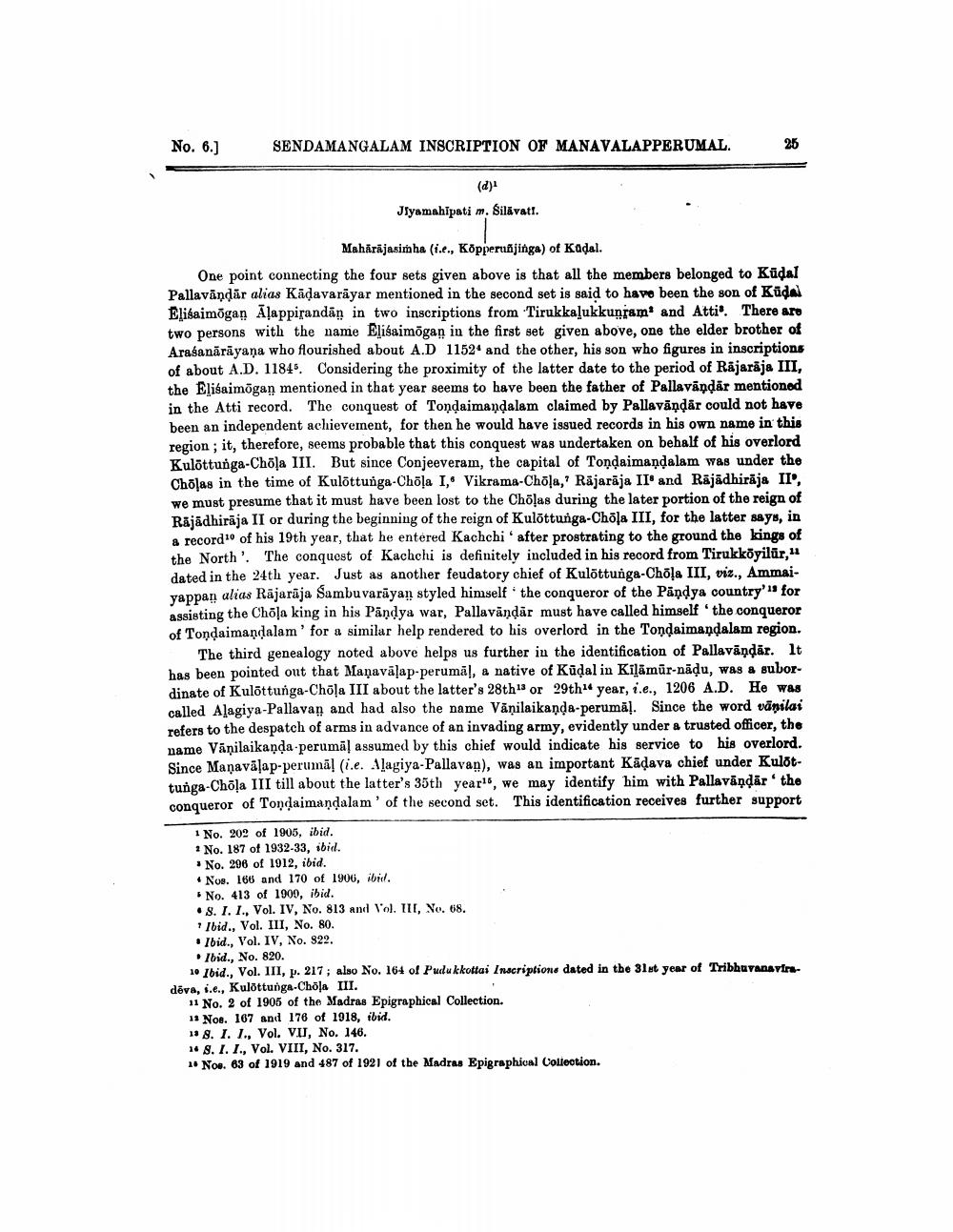________________
No. 6.)
SENDAMANGALAM INSCRIPTION OF MANAVALAPPERUMAL.
(d) Jiyamahipati m. Silavati.
Maharajasimha (i.e., Köpperußjinga) of Kadal. One point connecting the four sets given above is that all the members belonged to Kūdal Pallavāņdār alias Kādavarāyar mentioned in the second set is said to have been the son of Kudal Elisaimõgan Āļappirandan in two inscriptions from Tirukkalukkunram and Atti'. There aro two persons with the name Elisaimögan in the first set given above, one the elder brother of Arašanārāyaṇa who flourished about A.D 1152' and the other, his son who figures in inscriptions of about A.D. 1184. Considering the proximity of the latter date to the period of Rajaraja III, the Elisaimõgan mentioned in that year seems to have been the father of Pallavāņdār mentioned in the Atti record. The conquest of Tondaimaņdalam claimed by Pallavāņdār could not have been an independent achievement, for then he would have issued records in his own name in this region; it, therefore, seems probable that this conquest was undertaken on behalf of his overlord Kulottunga-Chola III. But since Conjeeveram, the capital of Tondaimandalam was under the Chõlas in the time of Kulõttunga-Chāļa 1, Vikrama-Chola,' Rājarāja II' and Rājādhirāja II', we must presume that it must have been lost to the Chöļas during the later portion of the reign of Rājādhirāja II or during the beginning of the reign of Kulõttunga-Chola III, for the latter says, in a record of his 19th year, that he entered Kachchi ' after prostrating to the ground the kings of the North'. The conquest of Kachchi is definitely included in his record from Tirukkoyilūr," dated in the 24th year. Just as another feudatory chief of Kulöttunga-Choļa III, viz., Ammaiyappan alias Rājarāja Sambuvariyan styled himself the conqueror of the Pandya country'" for assisting the Chola king in his Pandya war, Pallavāndār must have called himself the conqueror of Tondaimandalam' for a similar help rendered to his overlord in the Tondaimaņdalam region.
The third genealogy noted above helps us further in the identification of Pallavāņdār. It has been pointed out that Manavālap-perumal, a native of Kudal in Kilämūr-nādu, was a subordinate of Kulõttunga-Chöļa III about the latter's 28th" or 29th year, i.e., 1206 A.D. He was called Alagiya-Pallavan and had also the name Vănilaikanda-perumal. Since the word vänilai refers to the despatch of arms in advance of an invading army, evidently under a trusted officer, the name Vānilaikanda-perumāļ assumed by this chief would indicate his service to his overlord. Since Manavālap-perumā! (i.e. Alagiya-Pallavan), was an important Kādava chief under Kulottunga-Chola III till about the latter's 35th years, we may identify him with Pallavāņdār the conqueror of Tondaimandalam of the second set. This identification receives further support
1 No. 202 of 1905, ibid. No. 187 of 1932-33, ibid. No. 296 of 1912, ibid. • Nos. 166 and 170 of 1900, ibid.
No. 413 of 1909, ibid. .8. . I., Vol. IV, No. 813 and Vol. II, No. 68.
Ibid., Vol. III, No. 80. . Ibid., Vol. IV, No. 822.
Ibid., No. 820. 10 Ibid., Vol. III, p. 217; also No. 164 of Pudukkottai Inscription. dated in the 31st year of Tribhuvanavire dēva, i.e., Kulottunga-Chöļa III.
11 No. 2 of 1905 of the Madras Epigraphical Collection. 11 Nov. 167 and 178 of 1918, ibid. 10 8. I. I., Vol. VI, No. 146. 18. I. I., Vol. VIII, No. 317. 1. Noo. 63 of 1919 and 487 of 1921 of the Madras Epigraphical Collection.




